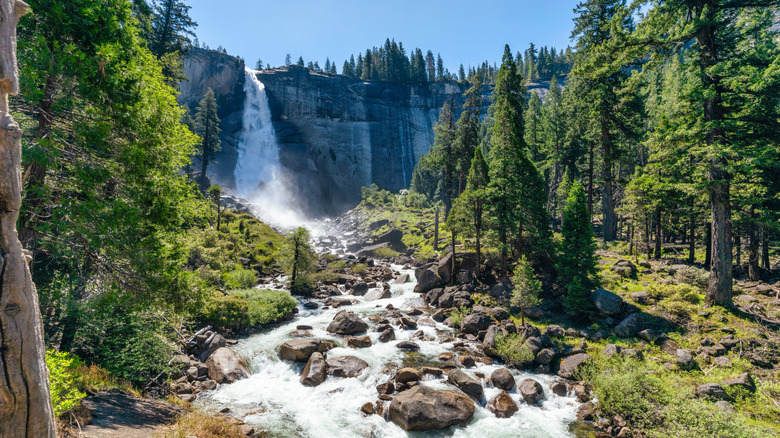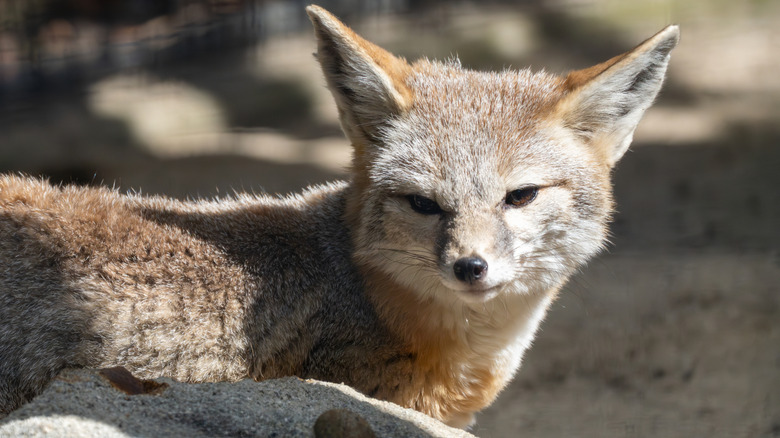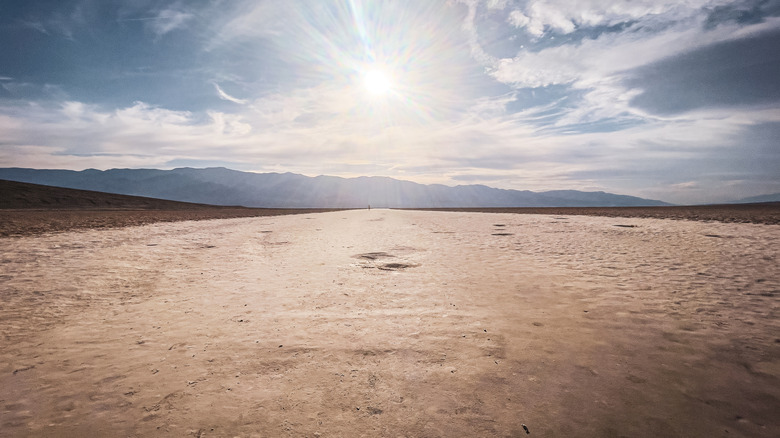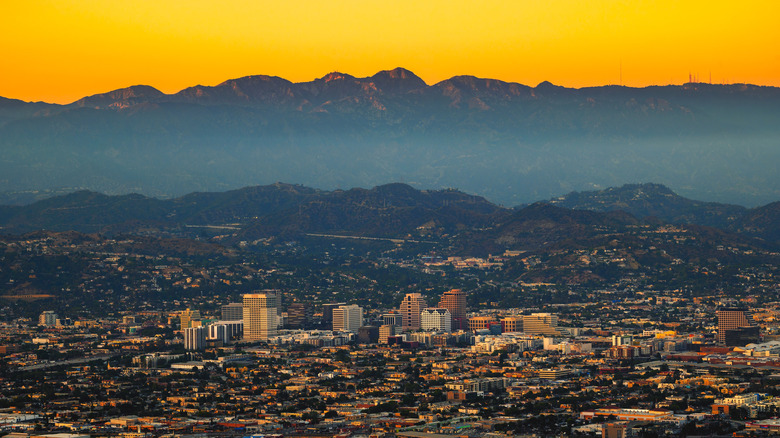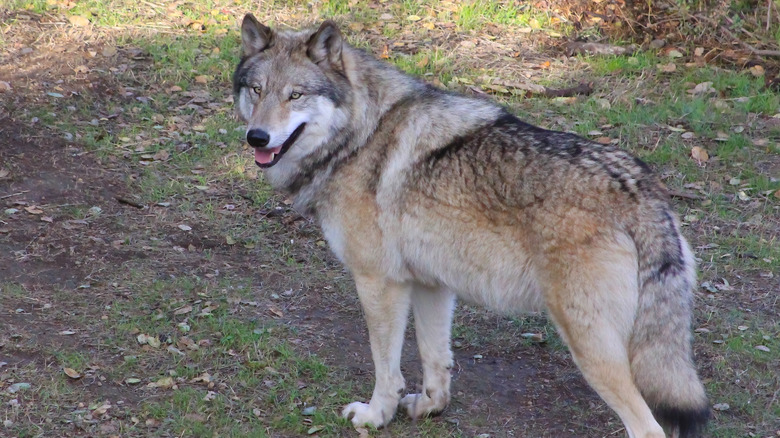California Holds A Grim Record For Animal Species In The United States
California is the most biodiverse state in the U.S., which means it is home to more plant and animal species than any other state. It hosts 6,500 types of plants, 68 amphibian species, 100 reptiles, 429 birds, 185 mammals, and more than 27,000 terrestrial invertebrates.
The Golden State is able to support such biodiversity due to its varied landscape, which includes oceans, mountains, and deserts, all of which allow for five different climate types: Desert, Cool Interior, Highland, Steppe, and Mediterranean. The state also has the highest and lowest places in the continental U.S. and is home to the tallest, largest, and oldest trees in the world. If that's not enough natural diversity for you, California even boasts the hottest place on earth.
But maintaining such a gloriously rich array of wildlife and natural habitats is a huge task — one which often comes with tragic setbacks. Just take a look at the state flag with its depiction of a California grizzly bear — an animal that went extinct in the state in the 1920s. Today, many other of California's diverse species face a similar fate. In fact, the state holds a grim record for the most endangered animals.
The number of animal species under threat in California
In November 2024, a team over at TotalVet used data from the U.S. Fish & Wildlife Service's Environmental Conservation Online System to identify the top 10 U.S. states with the most endangered animals. Lamentably, California is at the top of the list with 74 animal species currently designated as endangered. Since the state is a hotspot for rare species, this figure includes a number of animals endemic to California — meaning they only exist in the state — including the San Joaquin kit fox and the salt-marsh harvest mouse, aka the red-bellied harvest mouse.
There are a whole host of invasive species wreaking havoc in California, which is a major part of the problem. These non-native pests establish themselves in natural environments to the detriment of native plant and animal species, sapping sustenance and often irrevocably altering the ecosystem. As such, many species have either been wiped out or are currently facing a crisis. But invasive species are only one factor contributing to the endangerment of animals in the Golden State.
Climate change is wreaking havoc in California
California is facing multiple threats which contribute to the endangerment of its varied species. The definition of endangered species is, as per the United States Geological Survey, a species that is in danger of extinction "throughout all or a significant portion of its range." The designation "threatened," meanwhile, refers to a species that is "likely to become endangered within the foreseeable future."
In the Golden State, there are literally hundreds of animals that have been labelled as either threatened or endangered. The U.S. Fish & Wildlife Service Environmental Conservation Online System has a full list of these species, which number 293 in total.
Invasive species certainly play a role in such high numbers. According to the University of California, Davis, the state currently has 1,700 invaders which are taking a toll on natural habitats and endangering native animal and plant life. But there are some larger issues facing the state's wildlife. Firstly, climate change. Environmental law professor James Salzman told the Daily Bruin that rising average sea levels and rising temperatures have a detrimental impact on species that "evolved over many, many, many years for particular types of climates and timing." Meanwhile, associate professor of ecology and evolutionary biology Morgan Tingley used the example of the California spotted owl, which relies on forests made up of large trees which "have been around for hundreds of years." Unfortunately, extreme drought conditions coupled with heavy rains during nesting season have prevented the owls from reproducing as they would normally, which has led to the animals being listed as endangered. This is just one of many species impacted by climate change.
California's urbanization is a nightmare for natural habitats
By far one of the biggest issues facing California's wildlife is urbanization. Urban spread is actually the underlying cause of many of the other problems that lead to species becoming endangered. For example, as housing spreads, residents plant invasive species in their gardens, which then displace native species — not to mention the fact that new residents often bring pets, which similarly disturb local wildlife. What's more, human activity increases the chances of wildfires happening, which then wipe out natural habitats.
It's also worth noting that as urban areas are erected, ground temperatures go up and soil fertility often decreases, contributing to the difficulties faced by local plant life. Meanwhile, in a less obvious but just as significant result of urban expansion, buildings alter wind patterns which can actually damage vegetation. That's not to mention urban runoff polluting waterways.
None of this even takes into account perhaps the most obvious effect of urban expansion: the loss of natural habitats. Building more urban areas inherently decreases natural foraging areas, which many animals depend on for sustenance, with the golden eagle being one example of a species that has been heavily impacted by the loss of large foraging territories. In fact, as far back as 2001, the National Wildlife Federation was warning that urban sprawl — defined as "low density, automobile-dependent development into the natural areas outside of cities and towns" — was one of the biggest reasons why species in California were under threat. But there are numerous more recent studies that speak to the ongoing accuracy of that claim, such as a 2023 study which found that both climate change and urbanization had negatively impacted Los Angeles' bird population.
Which species are most under threat?
Of all the states in the U.S., California has the most species that can't be found anywhere else. But even animals that appear in other states are feeling the effects of the various threats facing the Golden State. The gray wolf is one such example. This canine almost went the way of the California grizzly bear, having been all but wiped out by the 1920s. But the species eventually started to make a return to California from nearby states, and today, while they are still endangered, the animals have made a significant comeback, with nine confirmed packs in the state. If efforts to support their population aren't maintained, however, gray wolves could easily be back where they were a century ago.
Elsewhere, Lange's metalmark butterfly is one striking example of just how threatened certain species are. In 2006, the amount of these butterflies, which are endemic to California and primarily found at Antioch Dunes Refuge, reached an all-time low of just 45 due to habitat loss. That's pretty staggering on its own, but even more so when you consider these butterflies numbered around 25,000 between 50 and 100 years ago.Sadly, as San Francisco expanded, the dunes where these butterflies live have been disrupted by mining efforts, greatly diminishing the numbers of Lange's metalmark butterflie in the state. Even today, there are thought to only be around 150.
In all, then, California is facing a multitude of issues that threaten its incredible biodiversity, making preservation efforts more important than ever.
